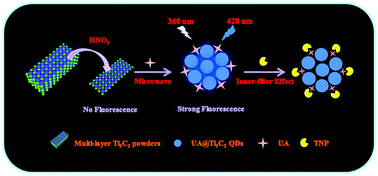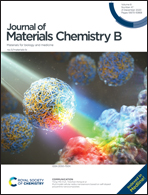A facile and rapid approach to synthesize uric acid-capped Ti3C2 MXene quantum dots for the sensitive determination of 2,4,6-trinitrophenol both on surfaces and in solution†
Abstract
Herein, uric acid@Ti3C2 quantum dots (UA@Ti3C2 QDs) were synthesized via a microwave-assisted strategy on the basis of acid etching and stripping. The UA@Ti3C2 QDs have bright blue emission. Intriguingly, the fluorescence emission of the UA@Ti3C2 QDs was significantly quenched after the addition of 2,4,6-trinitrophenol (TNP), due to inner-filter effect (IFE). Based on these findings, a novel environmentally friendly and water-soluble fluorescence probe based on UA@Ti3C2 QDs was demonstrated for the sensitive and selective detection of TNP. The method presented a wide linear range for TNP detection in the 0.01–40 μM range, with a low detection limit of 9.58 nM. Furthermore, the probe was successfully used for the sensitive detection of TNP in real water and smartphone-based colorimetric (SPBC) detection of TNP on surfaces with the linear range from 10.0 to 100.0 ng. On the whole, this work provides an effective strategy for the synthesis of UA@Ti3C2 QDs and an alternative fluorescence probe for detecting TNP both on surface and in solution.

- This article is part of the themed collection: Journal of Materials Chemistry B Lunar New Year collection 2021


 Please wait while we load your content...
Please wait while we load your content...